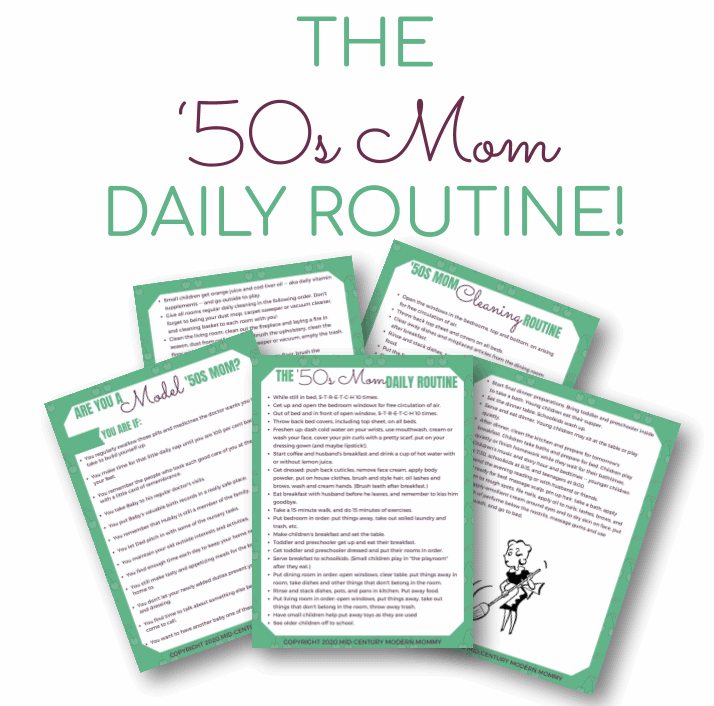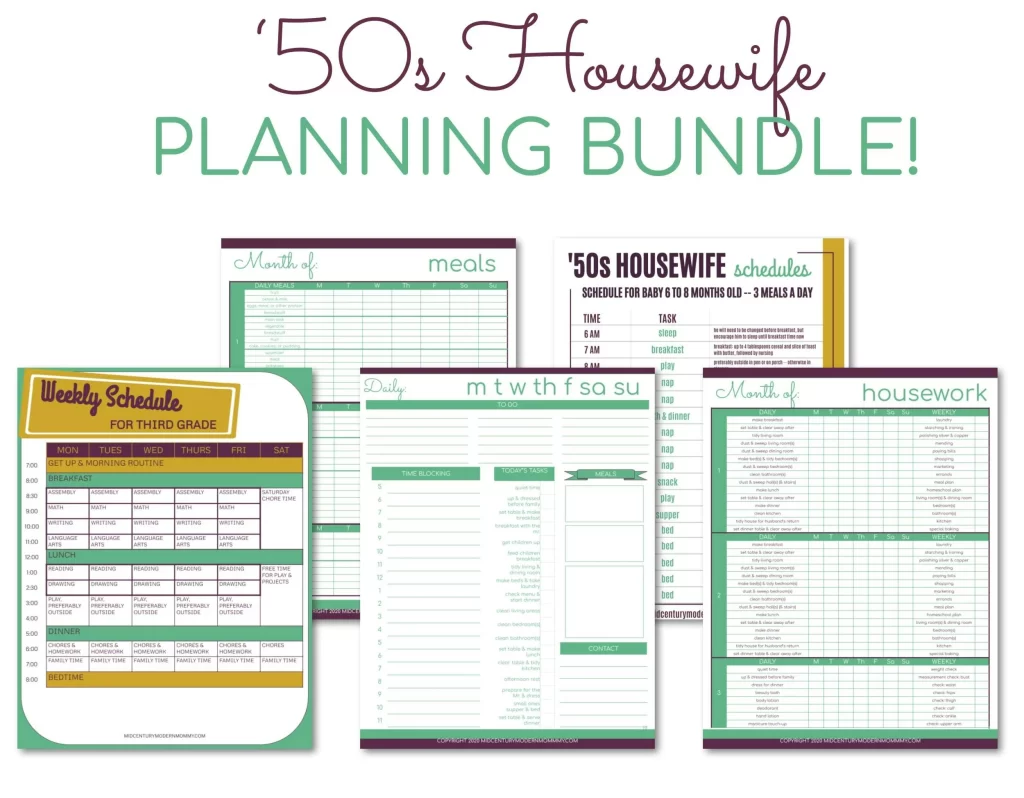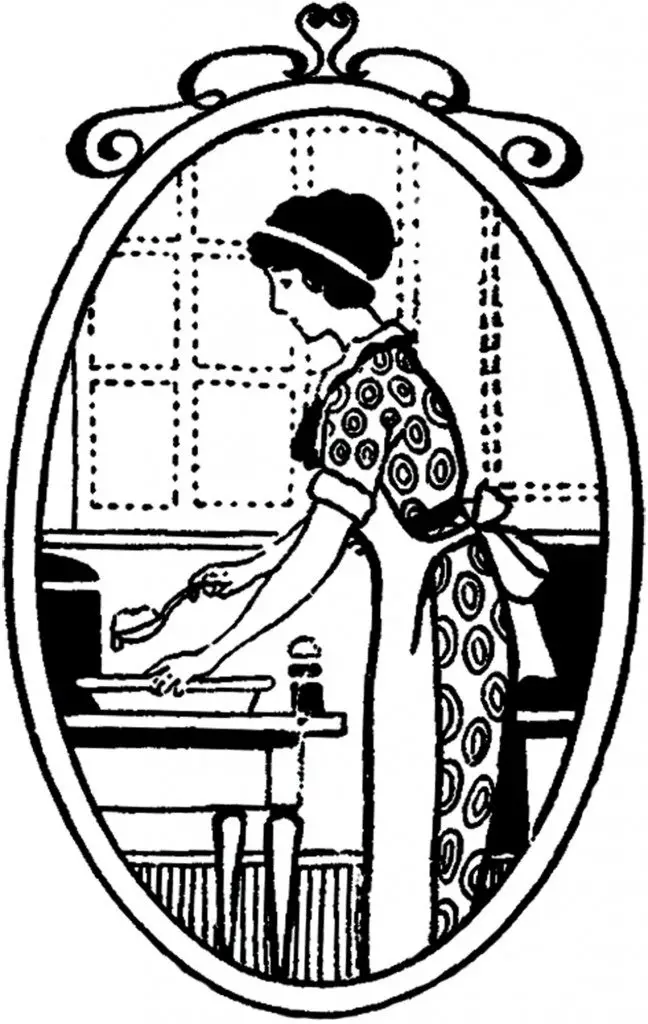The start of a new year is like opening the first page of a crisp, new journal. For so many of us, it’s a time to set goals and dream of ways to make the coming months more productive, beautiful, and fulfilling. Modern resolutions often focus on getting organized, losing weight, meal planning, and carving out time for self-care—and for good reason! But what if I told you there’s a way to achieve all of that and more, rooted in the timeless wisdom of a vintage housewife?

Get Our Mid-Century Mom Daily Routine FREE!
This post contains affiliate links. If you click a link and make a purchase, I may receive, at no additional cost to you, a small commission. Find out more on my Disclosures page, and thank you so much for your support!
Why Set Goals Like a Vintage Housewife?
Being a vintage housewife is about more than homemaking; it’s a return to simple elegance, intentional living, and values that bring both order and joy to daily life. It’s about creating a home that’s always ready for company, cooking nourishing meals, and maintaining a sense of personal grace—all while fostering deeper connections with your family and yourself. These aren’t just lofty ideals; they’re practical, achievable goals that fit seamlessly with the modern desire to live with purpose and balance.
Every New Year, we’re flooded with ideas on how to improve ourselves: get organized, lose weight, start meal planning, and focus on self-care. These goals all promise to bring balance and joy to our lives, but for many, they can feel overwhelming and disconnected from the day-to-day rhythm of home life. That’s where the vintage housewife lifestyle comes in—a timeless approach to homemaking and family care that’s as practical as it is inspiring.
The vintage housewife knew the power of structure and routine. A well-planned day meant a smooth-running home, time for meaningful connections with family, and space to maintain a sense of personal grace and beauty. It wasn’t about perfection; it was about intentionality—bringing elegance and purpose into the little things, from setting a pretty table to folding laundry with care.
What’s more, vintage goals complement many of our modern ambitions. Want to prioritize self-care? Daily beauty routines and moments of mindfulness were part of the vintage way. Looking to get organized? Homemaking schedules from the past emphasized efficiency and flow. Dreaming of a more meaningful life? A vintage housewife’s focus on family, hospitality, and purposeful living can transform your home into a haven of peace and creativity.

The 6 Areas of a Vintage Housewife Lifestyle
By focusing on the six core areas of vintage housewife life—homemaking, cooking, family care, personal appearance, budgeting, and hospitality—you’ll find a way to bring structure, beauty, and meaning into every corner of your day.
1. Homemaking and Home Appearance Goals

Your Home is the Foundation of Your Goals. For the vintage housewife, the home wasn’t just a place to eat and sleep—it was the center of family life, a sanctuary of comfort and beauty.
A well-maintained home creates a sense of calm and order, which sets the tone for the rest of your day. When your home is clean, organized, and thoughtfully decorated, it becomes a space where both you and your family can thrive. A tidy home isn’t about achieving perfection; it’s about creating an environment where life flows smoothly. When you know where things are and everything feels “just so,” there’s less stress and more room for joy.
Vintage housewives understood this, and they approached homemaking with pride and purpose, knowing that a well-run household gave their families the best possible foundation.
If you’re ready to transform your home into a haven, here are some practical vintage housewife home goals to help you get started:
Declutter, Organize, and Deep Clean Each Area of Your Home
I do this as part of my seasonal cleaning. The 2 methods of “spring cleaning” are to do it all at once seasonally, or to clean one room each month. And part of that is always going through your storage and your things being used or on display to switch them out seasonally.
My best vintage method for decluttering is to move clockwise around the room from the door, systematically emptying and sorting every box, drawer, and closet, top to bottom before I deep clean. (I use vintage methods that are very similar to Marie Kondo’s methods for organizing my storage afterward.)
Beautify Your Home with Vintage Touches
Arrange fresh flowers in a pretty vase on the dining table, polish your furniture to bring out its natural warmth, and decorate with “collections” that represent the interests, travels, and hobbies of the housewife — and her husband! It is the husband’s home, too. These small touches make your home feel special and add personality to your daily surroundings.
Create a Daily, Weekly, and Monthly Cleaning Schedule
I have so many of these, including my regular 1940s housekeeping plan, and a housekeeping schedule for 1950s working women. It is really quite important to have the schedule written down somewhere, so you can take the mental load of remembering all the little things that need to be done out of your working memory.
And you will also want some kind of seasonal cleaning routine, either a big cleaning quarterly or one area each month, that covers seasonal changes, decluttering, and organizing.

Actionable Home Goals for the New Year
Create a “Signature Look” for Your Home
Choose a vintage design theme for each room. A 1940s cottage-style kitchen or a 1950s Hollywood glam living room adds charm and cohesiveness.
Master One “Forgotten” Homemaking Skill
Learn timeless crafts such as French polishing furniture, mending socks, or making candles. These skills combine function and artistry.
2. Cooking and Kitchen Management Goals

In the vintage housewife’s world, the kitchen was a place to prepare food. It was also the heart of the home, where love and care were served up with every meal. And it was where the housewife focused her efforts on designing nutritious and strengthening meals that supported her children’s healthy development and her husband’s hard work.
I usually use recipes from the 1940s and earlier when I cook. With the exception of Julia Child and a few other chefs, cookbooks from the 1950s and later tend to focus on using convenience foods for shortcuts. Earlier cookbooks focus on dovetailing foods, planned leftovers, and compatible cooking methods as shortcuts. These earlier shortcuts are more compatible with my preferred from-scratch, whole foods cooking.
Here’s how to bring vintage cooking practices into your modern kitchen:
Perfect 2-3 Vintage Recipes Using Whole Foods
This is the very best place to start if you are not familiar with cooking. I start my children on cookie recipes from the Betty Crocker Cookie Book or on the “Susan” recipes from the Good Housekeeping Cookbook. They almost never fail. I look for recipes that are nutritious and do not use convience foods, like muffins or Russian teacakes. If there is something your family likes, learn to make it from scratch without having to look at the recipe. Or, try my easy vintage bread recipe and make your family’s bread.
Cook from Scratch at Least 5 Nights a Week
Set a goal to prepare meals using fresh, simple ingredients. If dinner is tough, do 6 breakfasts, or 6 breakfasts and lunches each week. The goal is to shift toward preparing your family’s food yourself so you a) know what’s in it, and b) can avoid the 70 million new food chemicals that are added to the industrial food stream each year.
Build a Library of Vintage Cookbooks
Start collecting vintage cookbooks to inspire your weekly menus. These books are treasure troves of simple, reliable recipes and often include full meal plans, tips for entertaining, and techniques for making the most of your pantry staples. I have multiple books with menus for every day of the year. I have a book that specifically focuses on weekday lunch menu plans for children in the menus section. I have one from England that has four full meals (breakfast, lunch/supper, dinner, and high tea) for every day of the year. I have menus for holidays, for company, for camping, and for different weather. Making menus is much easier when you have a lot of inspiration to draw on. Vintage magazines knew this — most of them have suggested menu plans every issue, too.
Stock a Pantry with Essentials
Follow the vintage tradition of keeping your pantry well-stocked with basics like flour, sugar, canned goods, and dried beans. A stocked pantry makes it easy to whip up a meal “off the shelf.” Vintage housewives also “planned” leftovers. Potato cakes and bread pudding are in the Anglo cooking traditions, while big pots of spaghetti sauce are more Italian, and pots of cooked beans are Spanish. What they all have in common is a plan to use the same food for multiple meals and reduce time spent in the kitchen. Leftovers are the best convenience foods.
Have a Clean, Well-Set Table for Your Meals
A snowy cloth on a well-set table is one of the linchpins of a homey home. A “domestic spice” as it were. And focusing on the table at mealtimes can help you find ONE THING to keep improving and make a pillar of your homemaking that your children will remember and will bring you joy. I try to make sure my table looks good, because it leads to better manners and more respect for the amount of work I have put in to creating the meal.
Maintain Dependable Meal Times
Consistent meal times help anchor your family’s day. Aim to serve breakfast, lunch, and dinner at roughly the same times each day. A dependable schedule promotes better digestion, instills routine, and gives everyone something to look forward to. That reliability translates to securely attached children who know that they will be taken care of (the same logic applies to bedtime routines) and a husband who feels appreciated (when you choose to make his favorite dishes, at a regular time, based on his work schedule — which is often interpreted as an act of love and respect).

Actionable Cooking Goals
Host a “Decade-Themed Dinner Party” Each Month
Recreate meals from a specific era, like a 1920s prohibition-style dinner or a 1950s barbecue.
Preserve 2 Family Recipes Every Week
Digitize family recipes and compile a scrapbook filled with personal notes and cherished anecdotes.
3. Marriage and Child-Rearing Goals

Intentional family care is about creating an environment where everyone feels valued and secure.
It’s about teaching children timeless virtues like respect, responsibility, and self-discipline, and building lasting memories through traditions and routines. And it’s about prioritizing your marriage to give your family a secure foundation.
A home filled with love and order gives children the stability they need to grow into confident, capable adults, and it strengthens the bonds that hold families together.
Here are some practical steps to bring vintage family values to life in your home:
Put Your Husband First
A strong family rests on the foundation of a strong marriage. Prioritize your husband. Treat him with dignity, avoid criticism, and show gratitude. Respect breeds intimacy and trust. Let your husband lead, even in minor matters like finances or everyday decisions, to build his confidence and improve mutual understanding. Do not criticize, nag, or demean. Relinquish control and stop micromanaging your husband’s actions and decisions.
Establish a Daily Rhythm
Create predictable routines and mealtimes that anchor your family’s day. You need routines for morning and bedtime that incorporate self-care for health and connection. Vintage morning routines for children included a big glass of water, making the bed, eating breakfast, getting dressed, teeth/hair/hands/face, and vitamins. Vintage bedtime routines included a bath, nursery supper, teeth/hair/hands/face, and getting tucked in with some form of connection–a story, a lullaby, etc. Even mealtimes included a regular routine of washing hands and face before and after each meal, changing for dinner, saying grace, and asking to be excused. Routines and rhythms provide children with a sense of security and structure, teach manners and self-discipline, and train children in basic self-care.
Plan Weekly Family Activities
Set aside time each week for family bonding. Sunday drives, family walks, and Saturday excursions to the park or a nearby museum are simple, low-cost ways to spend quality time together. Attending church as a family is a meaningful tradition that reinforces shared values. Encourage time alone with one parent or the other, especially father-son and mother-daughter activities.
Focus on Child-Rearing That Teaches Timeless Values
Raise your children with a focus on teaching manners, respect for authority, self-discipline, and life skills. Good manners start at home. Teach your children not to interrupt adults, to shake hands properly and make introductions, table manners, and to follow the Golden Rule. Overindulged children often lack charm and self-control. Balance love with discipline to avoid raising selfish or unruly children.
Read Aloud Daily Using Vintage Children’s Books
Choose vintage children’s books filled with beautiful illustrations, rich language, and captivating stories. You don’t need to teach morality through stories; you’re encouraging their imaginations and building rapport — they learn morality by watching you, not by reading. Literacy is about more than reading skill, it’s also about learning, so choose a range of books, and try to include children’s dictionaries and encyclopedias in the mix.
Encourage Screen-Free Play and Outdoor Time
Limit electronic distractions and encourage your children to engage with non-electronic toys, imaginative play, and outdoor activities. Whether it’s climbing trees, playing hopscotch, or building with blocks, these moments of creativity and freedom are essential for healthy development. As much as possible, try to encourage communal screen time, like TV or movies, or shared video games on a console. And avoid allowing screens in bedrooms — even your own! (If your husband agrees.)
Prioritize Education with Vintage Values
Emphasize the foundational “3Rs” (reading, writing, arithmetic) in your children’s education, along with physical activity and creative pursuits like learning a musical instrument or singing in a choir. These skills not only enrich their lives but also teach discipline and perseverance. Content, like history, social studies, and science, comes through literacy, so students need to practice (cursive) handwriting, reading aloud, answering comprehension questions, finding places on a globe or map, solving math problems, practicing an instrument (or voice), and moving their bodies every day. Then the books they read can provide learning about their own history and culture, learning about other’s history and culture, learning about nature and technology, and stories.
Create a Family Mission Statement
Sit down with your husband and ask him what he thinks are your family’s shared values and long-term goals — and really listen to his answer! Find ways to support his vision for the family. Perhaps you aim for financial stability, cultivate hobbies together, or prioritize traditions. For instance: “In 2024, our family will focus on gratitude, hospitality, and skill-building by hosting monthly dinners and learning new crafts.” Writing this down unites everyone in purpose and strengthens your family’s foundation.

Actionable Marriage and Family Goals
Plan a Year of Old-Fashioned Family Fun Every Week
Host game nights, build puzzles, or start a family lemonade stand. These activities teach thrift, creativity, and cooperation.
Teach Etiquette and Poise — 3 New Manners a Month
Introduce formal table settings, writing thank-you notes, and hosting as life skills.
Compliment Your Husband Every Day
Identify three specific things you admire about your husband each week and write them down. Use that list of specific things to verbally express your admiration for him to him each day.
4. Personal Appearance and Self-Care Goals

For the vintage housewife, looking polished and feeling your best is an act of self-respect, respect for your husband, and respect to those around you. Being slovenly was equated with bad manners and selfishness.
Taking the time to care for your appearance and well-being is not only for you, but it DOES also improve your own mental health. Prioritize your own well-being and personal development. A happy, fulfilled wife is an important component of a successful marriage.
Here are some practical steps to bring vintage self-care to life in your home:
Establish a Simple, Elegant Beauty Routine
Vintage beauty routines do not mean wearing makeup if you don’t WANT to. They mean focusing on health, fitness, posture, complexion, hair, nails, teeth, and feeling good. That means building a solid foundation of hair care, body care, skincare, nail care, and doctor and dentist appointments to create a foundation for beauty before you tackle hairstyles and makeup looks. Vintage beauty routines cover everything from baths to exercise to period care. Make sure your self care takes care of all of you.
Build a Vintage-Inspired Wardrobe
Curate timeless, quality pieces that reflect the elegance, modesty, and femininity of the midcentury style, while making “What Do I Wear?” decisions easier. Look for flattering dresses, tailored skirts, or cardigans in classic colors to use as a daily base outfit, and don’t forget pearls or a brooch for that finishing touch.
Prioritize Health and Fitness
Embrace vintage exercise routines like walking, dressage, ballet classes, or Pilates (yes, Pilates is midcentury!) to keep your body healthy, your figure neat, and your posture perfect. If you can, add in a social physical activity like skiing, tennis, golf, or hiking that you can do with your family or other ladies. And ALWAYS learn social dance!
Set Morning and Evening Routines
A structured morning routine that includes dressing and beauty from top to toe and a moment of reflection and planning is important for your mental health. In the evening, unwind with a beauty bath, a quiet cup of tea, and reading to care for both your body and mind.
Personal Fulfillment Through Homemaking
Homemaking can be a deeply creative and satisfying outlet. Try tying tasks to self-expression, like designing seasonal decoration, experimenting with flower arrangements, or sewing unique home accents. Learning vintage domestic arts—such as embroidery, canning, or baking heirloom recipes—adds beauty and depth to your daily routine.

Actionable Self-Care and Beauty Goals
Set “Style Challenges” to Reclaim Elegance
Wear dresses or skirts daily for a year or try a new vintage hairstyle each week to embrace midcentury beauty standards.
Prioritize Restorative Self-Care
Include a beauty bath in your evening routine, and 15 minutes of exercise in your morning routine.
Get Up 30 Minutes Before the Rest of Your Family Every Day
Use this time to dress and do your hair and makeup before anyone else in the family is up.
5. Budgeting and Home Finance Goals

Frugality is a vintage value. A vintage housewife knew how important it was to manage her household resources wisely. Frugality wasn’t about deprivation—it was about creativity and respect. Sustainable living and underconsumption aren’t new — thrift was heralded, lauded and praised in American culture as far back as the 1600s.
Here are some practical steps to bring vintage financial wisdom to life in your home:
Create a Homemaking Budget
Vintage housewives did not have a budget of expenses and savings, especially if their husbands were in charge of finances. Rather, they knew in advance how much money they’d have for food, clothes, household help, and the children’s needs each month while their husbands were responsible for housing costs, utilities, savings, and all the other “fixed costs” in a modern budget. A reasonable “housekeeping allowance” is still the best way to plan your monthly expenditures, very similar to a cash envelope system (which dates to the 1920s, by the way!).
Start Meal Planning
Planning meals ahead of time not only cuts grocery costs but also eliminates the last-minute scramble to figure out breakfast, lunch, and dinner that throws regular mealtimes out of whack. The more you plan, the more you learn to keep costs low AND keep meals healthy, because the best way to save money on medical bills is for the housewife to keep the family as healthy as possible (vintage value). In a modern era where medical costs are not being properly covered by medical insurers, good health can start in our homes.
Learn Vintage Frugal Skills
Sewing, mending, and DIY projects extend the life of your wardrobe and household items. Cooking from scratch costs less for good-quality food (bread is a good example). Even vintage ways of dressing for the seasons, dealing with cold in the winter or heat in the summer, and cleaning can make a difference in your bills!

Actionable Budgeting Goals
Practice Vintage Frugality Challenges
Adopt a “make it do, or do without” mantra, or try a “buy local only month” inspired by wartime simplicity.
6. Hospitality and Community Life Goals

Hospitality was a hallmark of the vintage housewife. And hospitality is more than just entertaining; it’s about creating a welcoming space where people feel valued and cared for. Also, being an active part of your community can be deeply fulfilling. Here are some practical steps to bring vintage hospitality to life in your home:
Plan Regular Gatherings
Vintage housewives hosted casual dinners for friends, company dinners for networking, tea and coffee for the neighboring wives, parties for children, cocktail parties, bridge parties, club luncheons, weekend guests… the list is long! And they had systems, because they knew that practice makes perfect. If you don’t host, you won’t get comfortable hosting. But don’t get to ambitious at first! Practice before you throw a formal dinner for the husband’s boss.
Create a Welcoming Environment
Focus on clean, comfortable spaces, fresh linens, fresh air, fresh flowers. It shows your guests that you’ve put thought and care into their visit. More importantly, make it nice and clean, cozy and comfortable, and homey for your husband and children. It’s better to have things out of place or your husband’s sentimental items that “mess up”
Give Back to the Community
Use your homemaking skills to contribute to your community, whether it’s baking for a fundraiser, sewing for a charity, or simply checking in on a neighbor in need.
Create New Family Traditions
Use holidays and milestones as opportunities to establish traditions that bring your family closer together. From annual picnics to Christmas cookie exchanges, these rituals become the fabric of your family’s legacy.

Actionable Hospitality Goals
Host a Neighborhood Open House for Christmas
Or find other ways to revive community connections with block parties, neighbor gift exchanges, or tea gatherings.
Volunteer For at Least 4 Hours a Month
Use your skills to support the community, such as baking for fundraisers or sewing for charities.
How do I know what goals to set?

Here are the steps I follow:
- Write out your vision for the future
- Reverse engineer it into a 5-year goal
- Then a 1-year goal
- Then monthly goals
So where does that first step, the vision, come from? I usually start by finding vintage illustrations that have the “feeling” that I want my home/life/family to have. I sort them by color, activities, seasons, and locations, and make a vision board for each of the 6 areas of vintage homemaking. When I have enough (there are a ton out there), then I write out my vision while I look at my images. I try to have my vision answer these questions:
- If you had all the money in the world, what would your average day look like?
- What kind of house do you want to live in? Is there a specific location? Do you want to travel?
- What do you want family life to look like? Visualize an average day of family time.
- How long of a workday do you want to have? If you could do anything, what would you do for work? (This includes unpaid housewife work, too.)
- How do you want to look and feel? Describe your body, energy levels, and how you want to present yourself to the world.
- What does your ideal day look like? Map out every hour.
- List out anything else that comes to mind in terms of a specific future that you want to build for yourself.
Then I write out an anti-vision, to clear up any uncertainties:
- What is the bane of your existence?
- Write out the opposite of every question about your vision.
If I get stuck, I compare my vision to the vintage advice and lists I have compiled over the years. I have self-improvement lists, housekeeping lists, home furnishing and organization lists, beauty and self-care lists — I even have step-by-step instructions for getting dressed, vintage style, including foundation garments.
When I am finished, I have a foundation that I call my “aspirational goals.” From here, I can start to create a plan that will achieve the vision I want for myself.
How to Create a Vintage Housewife Goals Tracker

Setting goals is one thing—keeping track of them is another. I prefer pen and paper to a digital tool, but any well-thought-out tracker can be your secret weapon for success.
Use a Notebook, Printable Binder, or Bullet Journal
Choose a method that inspires you and fits your lifestyle. I will always prefer analog systems. I have a yearly agenda for keeping track of the family’s important dates, appointments, etc. I keep my homemaking reference books and cook books at my housekeeping desks so that I can refer to the hard copies. I also keep my card file here, and my checklists on a clipboard. (I do like to hand write or type up my checklists, though!)
Break Goals Down by Month, Week, and Day
Divide your big goals into manageable chunks. Begin with task lists for recurring things and project lists for one-time endeavours. Then classify each activity on your task list by daily, weekly, monthly, seasonal, or annual reoccurrence. (The more complete your task lists are, the more they help, so write down everything!)
Track Progress with Routines, Checklists, and Rewards
Routines are systems of reoccurring tasks. That’s it. Checklists are to help you remember a routine until it becomes second nature. (It usually doesn’t become second nature to ADHD brains, which is why checklists can help you stay mentally organized.) And ofcourse, rewards can be a form of self-care. I recommend having 2 lists, one of things that make you happy and one of things that make you feel good physically, and choosing 3 things a day to do for yourself every day (at least one from each list!).
Create a Homemaking Vision Board
Use clippings from magazines and inspirational quotes to visualize your goals.
Adopt a Journal for Self-Reflection and Progress
Document achievements and reflections in a journal or daily agenda, noting gratitude entries and milestones.

Staying Motivated to Achieve Your Vintage Housewife Goals
Staying motivated is about finding joy in the process and giving yourself grace when things don’t go perfectly.
Start with one area, like homemaking or cooking, and add more goals over time.
Build Routines That Feel Joyful, Not Overwhelming
Your routines should serve you, not stress you. Incorporate small touches that bring happiness to your day, like playing your favorite music while cleaning or lighting candles at the dinner table. A joyful mindset makes even the busiest days more manageable.
Set Realistic, Achievable Goals
Start small and build as you go. Focus on one or two areas at a time—like establishing a morning cleaning routine or planning weekly meals—and let your success in those areas inspire you to tackle more.
Celebrate Small Wins and Progress
Acknowledge your efforts, even if they seem minor. Did you stick to your cleaning schedule for a week? Finally perfect that pie crust? Celebrate those moments as proof that you’re moving in the right direction.
Find Inspiration in Vintage Role Models
Look to midcentury homemakers, old-fashioned homemaking books, or vintage magazines for ideas and encouragement. Seeing how others embraced their roles with grace and creativity can spark fresh motivation for your journey.
Reclaim the Idea of Service as a Virtue
Approach homemaking as an act of love and generosity. Find meaning in everyday tasks, like baking bread or ironing clothes, as contributions to your family’s happiness.
Embrace the Slower Pace of Vintage Living
Simple activities, like hanging laundry to dry or cooking from scratch, bring mindfulness and satisfaction to daily life.
Romanticize Your Daily Life
After all, why should tradwives have all the fun?


Timeless homemaking values, such as respect, creativity, and discipline, can seamlessly align with modern family life. Take the first step to a beautifully organized, vintage-inspired life today!

Get Our Mid-Century Mom Daily Routine FREE!




